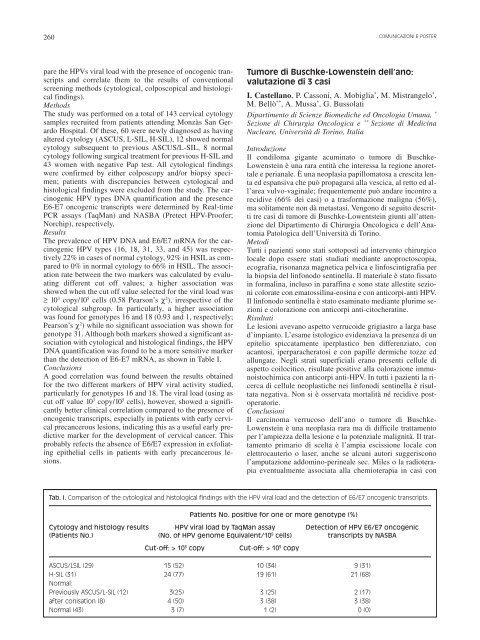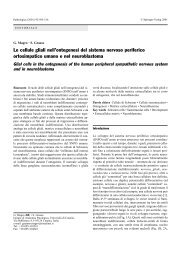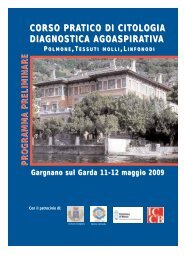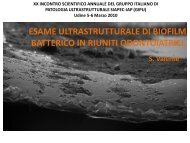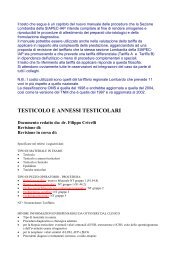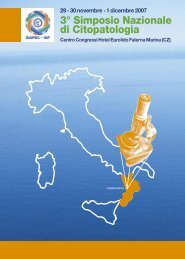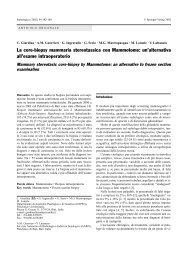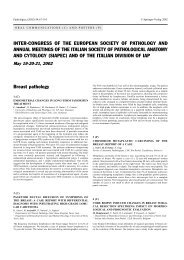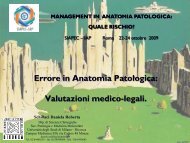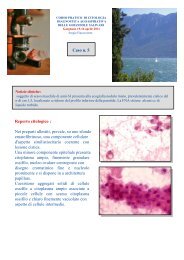pag. 216-318 - Siapec
pag. 216-318 - Siapec
pag. 216-318 - Siapec
You also want an ePaper? Increase the reach of your titles
YUMPU automatically turns print PDFs into web optimized ePapers that Google loves.
260<br />
COMUNICAZIONI E POSTER<br />
pare the HPVs viral load with the presence of oncogenic transcripts<br />
and correlate them to the results of conventional<br />
screening methods (cytological, colposcopical and histological<br />
findings).<br />
Methods<br />
The study was performed on a total of 143 cervical cytology<br />
samples recruited from patients attending Monzàs San Gerardo<br />
Hospital. Of these, 60 were newly diagnosed as having<br />
altered cytology (ASCUS, L-SIL, H-SIL), 12 showed normal<br />
cytology subsequent to previous ASCUS/L-SIL, 8 normal<br />
cytology following surgical treatment for previous H-SIL and<br />
43 women with negative Pap test. All cytological findings<br />
were confirmed by either colposcopy and/or biopsy specimen;<br />
patients with discrepancies between cytological and<br />
histological findings were excluded from the study. The carcinogenic<br />
HPV types DNA quantification and the presence<br />
E6-E7 oncogenic transcripts were determined by Real-time<br />
PCR assays (TaqMan) and NASBA (Pretect HPV-Proofer;<br />
Norchip), respectively.<br />
Results<br />
The prevalence of HPV DNA and E6/E7 mRNA for the carcinogenic<br />
HPV types (16, 18, 31, 33, and 45) was respectively<br />
22% in cases of normal cytology, 92% in HSIL as compared<br />
to 0% in normal cytology to 66% in HSIL. The association<br />
rate between the two markers was calculated by evaluating<br />
different cut off values; a higher association was<br />
showed when the cut off value selected for the viral load was<br />
≥ 10 3 copy/10 5 cells (0.58 Pearson’s χ 2 ), irrespective of the<br />
cytological subgroup. In particularly, a higher association<br />
was found for genotypes 16 and 18 (0.93 and 1, respectively;<br />
Pearson’s χ 2 ) while no significant association was shown for<br />
genotype 31. Although both markers showed a significant association<br />
with cytological and histological findings, the HPV<br />
DNA quantification was found to be a more sensitive marker<br />
than the detection of E6-E7 mRNA, as shown in Table I.<br />
Conclusions<br />
A good correlation was found between the results obtained<br />
for the two different markers of HPV viral activity studied,<br />
particularly for genotypes 16 and 18. The viral load (using as<br />
cut off value 10 3 copy/10 5 cells), however, showed a significantly<br />
better clinical correlation compared to the presence of<br />
oncogenic transcripts, especially in patients with early cervical<br />
precancerous lesions, indicating this as a useful early predictive<br />
marker for the development of cervical cancer. This<br />
probably refects the absence of E6/E7 expression in exfoliating<br />
epithelial cells in patients with early precancerous lesions.<br />
Tumore di Buschke-Lowenstein dell’ano:<br />
valutazione di 3 casi<br />
I. Castellano, P. Cassoni, A. Mobiglia * , M. Mistrangelo * ,<br />
M. Bellò ** , A. Mussa * , G. Bussolati<br />
Dipartimento di Scienze Biomediche ed Oncologia Umana, *<br />
Sezione di Chirurgia Oncologica e ** Sezione di Medicina<br />
Nucleare, Università di Torino, Italia<br />
Introduzione<br />
Il condiloma gigante acuminato o tumore di Buschke-<br />
Lowenstein è una rara entità che interessa la regione anorettale<br />
e perianale. È una neoplasia papillomatosa a crescita lenta<br />
ed espansiva che può pro<strong>pag</strong>arsi alla vescica, al retto ed all’area<br />
vulvo-vaginale; frequentemente può andare incontro a<br />
recidive (66% dei casi) o a trasformazione maligna (56%),<br />
ma solitamente non dà metastasi. Vengono di seguito descritti<br />
tre casi di tumore di Buschke-Lowentstein giunti all’attenzione<br />
del Dipartimento di Chirurgia Oncologica e dell’Anatomia<br />
Patologica dell’Università di Torino.<br />
Metodi<br />
Tutti i pazienti sono stati sottoposti ad intervento chirurgico<br />
locale dopo essere stati studiati mediante anoproctoscopia,<br />
ecografia, risonanza magnetica pelvica e linfoscintigrafia per<br />
la biopsia del linfonodo sentinella. Il materiale è stato fissato<br />
in formalina, incluso in paraffina e sono state allestite sezioni<br />
colorate con ematossilina-eosina e con anticorpi-anti HPV.<br />
Il linfonodo sentinella è stato esaminato mediante plurime sezioni<br />
e colorazione con anticorpi anti-citocheratine.<br />
Risultati<br />
Le lesioni avevano aspetto verrucoide grigiastro a larga base<br />
d’impianto. L’esame istologico evidenziava la presenza di un<br />
epitelio spiccatamente iperplastico ben differenziato, con<br />
acantosi, iperparacheratosi e con papille dermiche tozze ed<br />
allungate. Negli strati superficiali erano presenti cellule di<br />
aspetto coilocitico, risultate positive alla colorazione immunoistochimica<br />
con anticorpi anti-HPV. In tutti i pazienti la ricerca<br />
di cellule neoplastiche nei linfonodi sentinella è risultata<br />
negativa. Non si è osservata mortalità né recidive postoperatorie.<br />
Conclusioni<br />
Il carcinoma verrucoso dell’ano o tumore di Buschke-<br />
Lowenstein è una neoplasia rara ma di difficile trattamento<br />
per l’ampiezza della lesione e la potenziale malignità. Il trattamento<br />
primario di scelta è l’ampia escissione locale con<br />
elettrocauterio o laser, anche se alcuni autori suggeriscono<br />
l’amputazione addomino-perineale sec. Miles o la radioterapia<br />
eventualmente associata alla chemioterapia in casi con<br />
Tab. I. Comparison of the cytological and histological findings with the HPV viral load and the detection of E6/E7 oncogenic transcripts.<br />
Patients No. positive for one or more genotype (%)<br />
Cytology and histology results HPV viral load by TaqMan assay Detection of HPV E6/E7 oncogenic<br />
(Patients No.) (No. of HPV genome Equivalent/10 5 cells) transcripts by NASBA<br />
Cut-off: > 10 3 copy<br />
Cut-off: > 10 5 copy<br />
ASCUS/LSIL (29) 15 (52) 10 (34) 9 (31)<br />
H-SIL (31) 24 (77) 19 (61) 21 (68)<br />
Normal:<br />
Previously ASCUS/L-SIL (12) 3(25) 3 (25) 2 (17)<br />
after conisation (8) 4 (50) 3 (38) 3 (38)<br />
Normal (43) 3 (7) 1 (2) 0 (0)


